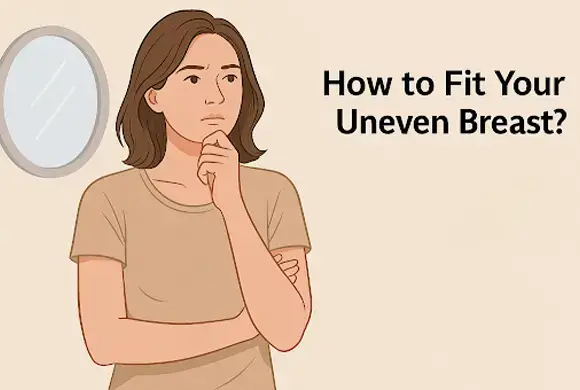If you’ve ever stood in front of the mirror and noticed that one breast looks a little bigger, fuller, or sits higher than the other, let me tell you this—you’re not alone. Uneven breasts, also called breast asymmetry, are incredibly common. In fact, most women experience it to some degree, even if no one talks about it openly.
I know it can feel uncomfortable, even frustrating, especially when bras don’t fit quite right or outfits highlight the difference. But here’s the truth: it’s normal, natural and nothing to be ashamed of. As someone who has worked closely with women facing these concerns, I can assure you that you don’t need to “fix” your body—you just need the right bra to support it.
Think of this blog as your personal guide. Together, we’ll go through why uneven breasts happen, how common they really are, the challenges you might face and—most importantly—how to choose bras that fit beautifully so you can feel comfortable and confident every single day.
Breast asymmetry affects over 85% of women, ranging from minor size differences to more noticeable imbalances. According to Dr Anmol Chugh, CK Birla Hospital, corrective options include augmentation for smaller breasts, reduction for larger ones, or breast lifts to improve shape and position. Non-surgical fixes like specialised bras or inserts can also help balance appearance. Whether you choose simple adjustments or medical procedures, the goal is the same—comfort, confidence and body positivity.
Why Do Women Have Uneven Breasts?
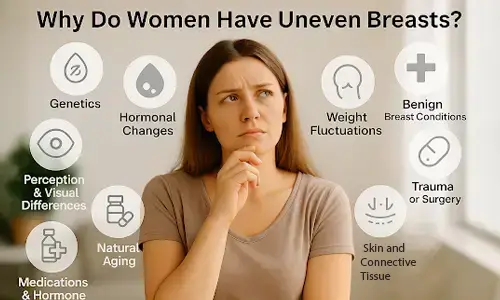
Uneven breasts, also called breast asymmetry, are very common—most women notice at least a slight difference in size, shape, or position between their breasts. Perfect symmetry is rare in the human body and breasts are no exception. Here are the most common reasons why this happens:
1. Normal Development and Genetics
- Puberty: During adolescence, breasts don’t always develop at the same pace. One side may grow faster, leaving a temporary or sometimes permanent difference in size.
- Anatomical variations: Just like eyebrows, hands, or feet aren’t perfectly identical, breasts naturally vary a little. A small difference is completely normal and part of your genetic makeup.
2. Hormonal Changes
- Menstrual cycle: Hormone levels rise and fall throughout the month. This can cause swelling and sensitivity in the breasts, sometimes more on one side than the other.
- Pregnancy and breastfeeding: Hormones during pregnancy stimulate breast growth, but one side may respond more strongly. Later, babies often prefer one breast for feeding, making it fuller than the other. These changes are usually temporary but can leave a lasting difference for some women.
- Menopause: As oestrogen levels decline, breast tissue shrinks and changes. One side may reduce faster than the other, leading to unevenness.
3. Weight Fluctuations
Breasts are mostly fatty tissue. Gaining or losing weight can change their size and shape and it’s not uncommon for one breast to be affected more than the other.
4. Benign Breast Conditions
Non-cancerous issues such as cysts, fibrous tissue growth, or fat necrosis (from injury) can cause swelling or lumps that make one breast look different.
5. Medical Conditions
In rare cases, congenital conditions lead to more noticeable asymmetry:
- Poland syndrome: The chest muscle doesn’t fully develop on one side, making the breast appear smaller.
- Juvenile hypertrophy: One breast grows excessively during puberty, while the other remains smaller.
6. Trauma or Surgery
An injury to the chest—especially during childhood—or surgical procedures like a lumpectomy, mastectomy, or radiation therapy can change breast size and shape.
7. Posture and Lifestyle Habits
Long-term habits such as slouching, sleeping predominantly on one side, or carrying heavy bags on one shoulder can affect how breasts sit on the chest, exaggerating natural differences.
8. Exercise and Muscle Development
Sports or gym workouts that build chest muscles (like tennis, swimming, or weightlifting) can cause uneven pectoral development. This doesn’t change the breast tissue itself but can make one breast appear higher or fuller.
9. Natural Ageing Process
Over time, gravity, skin elasticity and ligament strength affect each breast slightly differently. As a result, one breast may sag or lose volume faster than the other.
10. Skin and Connective Tissue Health
Factors like rapid weight loss, sun damage, or certain connective tissue conditions can reduce elasticity unevenly, making one breast droop more than the other.
11. Medications and Hormone Therapy
Long-term hormonal treatments, such as birth control, fertility medications, or hormone replacement therapy, can cause uneven breast changes—especially if one side is more hormonally sensitive.
12. Perception and Visual Differences
Sometimes the asymmetry is less significant than it feels. Lighting, posture, or viewing angle can exaggerate the difference. Many women believe their breasts are “very uneven”, when in reality, the variation is small and hardly noticeable to others.
Challenges Women Face with Uneven Breasts
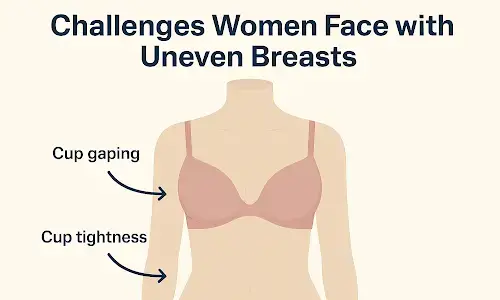
Uneven breasts may be common, but that doesn’t mean they don’t create everyday struggles. Many women notice that bras never seem to fit both sides equally—one cup gaps on the smaller breast, while the other feels too tight on the larger side. This can lead to constant adjusting, discomfort and frustration.
Clothing can make things trickier too. Fitted tops, blouses and swimwear sometimes highlight the difference, leaving women feeling self-conscious. And when it comes to shopping, choosing a bra size can feel like a no-win situation—do you fit the smaller side and risk spillage, or fit the larger side and deal with gaping?
The good news is, these challenges don’t mean you’re stuck. With the right fitting approach, you can easily work around breast asymmetry and feel comfortable in your bras. That brings us to the next part—how to fit a bra for uneven breasts.
How to Fit a Bra for Uneven Breasts (Step-by-Step Guide)
Uneven breasts don’t have to mean uneven confidence. The secret is to focus on balance rather than perfection. With the right adjustments, your bra can support both sides beautifully. Here’s how you can do it:
Start With the Larger Breast
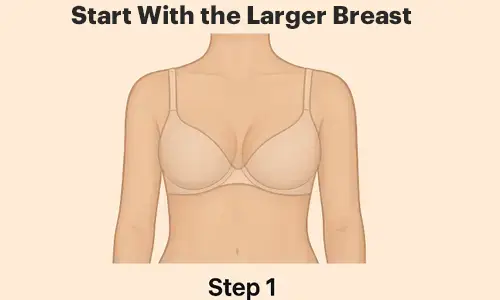
Always measure and fit your bra to the bigger side. This ensures you have the proper coverage and support where it’s needed most. If you size down for the smaller side, you’ll risk spillage and discomfort on the larger one.
Create Harmony With Padding
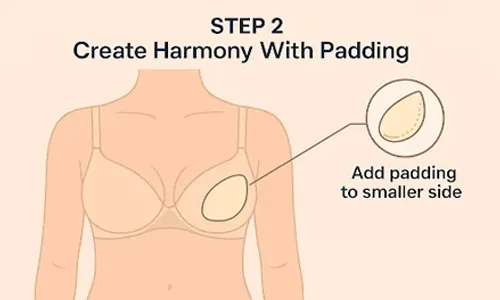
For the smaller breast, add a removable insert or lightweight pad. These simple tools fill out the cup gently and give your bust a balanced look without anyone noticing the difference.
Play With Strap Adjustments
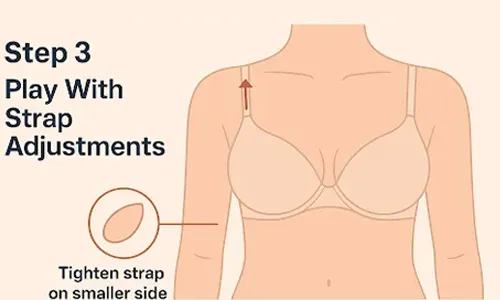
Straps don’t have to be identical. Tighten the strap on the smaller side a little more—it adds subtle lift and helps both breasts sit at a more even level. It’s a small tweak that can transform your fit.
Opt for Forgiving Fabrics
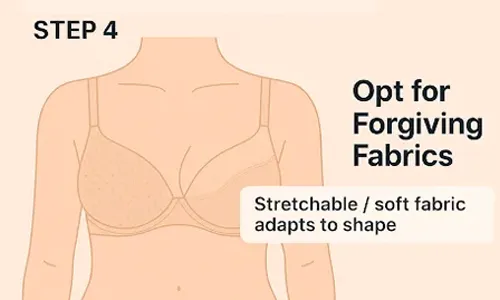
Look for bras with stretchable cups, soft lace or lightly lined material. These fabrics adapt to the natural shape of each breast, so you won’t have one side sitting snug while the other gapes.
Test Different Styles Before Deciding
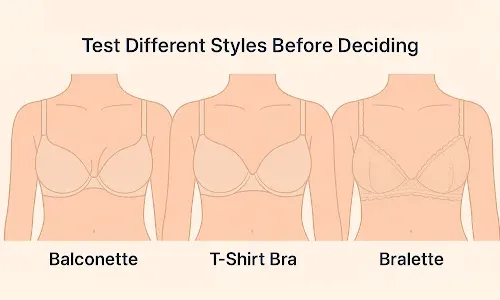
Don’t be discouraged if one bra doesn’t work—every style and brand has a unique cut. Trying balconettes, T-shirt bras and bralettes will help you see which feels best for your body. Think of it as finding a friend that understands your shape.
Best Bra Styles for Uneven Breasts
Certain bra styles are more forgiving and supportive when you’re dealing with asymmetry. Here are some of the best options:
- T-shirt bras with removable padding - Let you customise each side.
- Balconette bras - Provide great shape and lift without drawing attention to unevenness.
- Bralettes - Stretchy and comfortable, perfect for mild differences.
- Custom-fit or dual-size bras - Designed for women with a noticeable cup difference.
And when you’re shopping, knowing the right styles is only half the story. The way you shop and what you look for in a bra can make the process a lot easier.
Tips for Bra Shopping with Uneven Breasts
Shopping for bras when you have uneven breasts doesn’t have to feel intimidating. Keep these tips in mind:
- Look for bras with removable cups or inserts—they give you flexibility.
- Ask for professional help—fitters see this often and can give great advice.
- Don’t stress over size labels—comfort is more important than the number on the tag.
- Be open to different brands and styles—sometimes the unexpected works best.
But what if your size difference is more than one cup? That’s where a unique option comes in: bras with two different cup sizes.
Can You Wear Two Different Cup Sizes?
Absolutely, you can. For women with a noticeable size difference—often more than one cup—some lingerie brands now create bras that are designed with two different cup sizes in the same bra. This means you no longer have to compromise by choosing a size that only fits one side properly. These bras can feel like a game-changer because they offer a more tailored fit and reduce the frustration of gaping or spillage.
Not everyone needs a speciality bra. If the difference between your breasts is mild, simpler solutions often work just as well. Using removable padding on the smaller side, adjusting straps individually, or choosing bras with stretchable fabrics can easily create balance without the need for a custom or dual-size design.
Your breasts don’t need to be “perfect” to be beautiful. The right bra simply highlights what’s already unique and wonderful about you.
The goal isn’t to change who you are, but to give you the comfort and support you deserve. Because true beauty starts with confidence—and that’s something every woman already carries within her.

